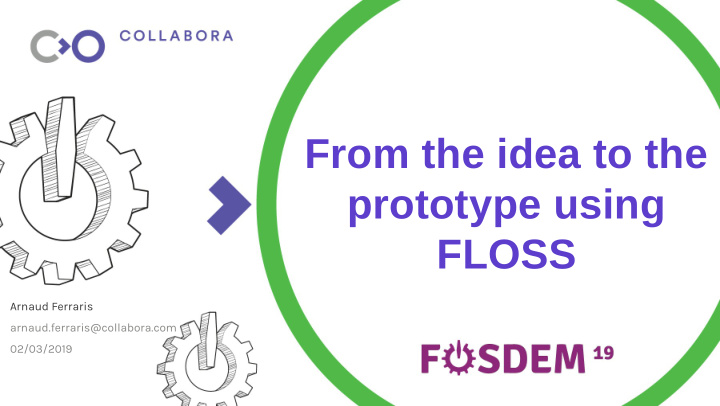



From the idea to the prototype using FLOSS Arnaud Ferraris arnaud.ferraris@collabora.com 02/03/2019 1
Who am I? ● Software Engineer at Collabora Low-level development (kernel, bootloader, base system …* ) – Embedded software – ● Formerly owner of A-wai Amplification Designed & crafted custom tube amplifiers for guitar and bass guitar – First real-world experience with electronics design – 2
From the idea to the prototype using FLOSS ● Testing & validating your idea ● Designing the PCB ● A case for your project 3
Testing & validating your idea 4
Testing & validating your idea ● Innovative idea Can it work? – Will it work? – ● When in doubt, simulate! Qucs http://qucs.sourceforge.net/ – Ngspice http://ngspice.sourceforge.net/ – ● Draft schematics Good old paper – JSchem http://jschem.bplaced.net/ – 5
Proof of Concept ● Off-the-shelf modules Adafruit – Sparkfun – Seeedstudio – ● Breadboard ● Prototype shield 6
Components selection ● Widely available ● Available, comprehensive and correct datasheets ● Sufficient performances ● Though-hole mounting 7
The proto-prototype ● Validate global hardware design ● Lots of trial & error Modification-friendly platform – ● Not a prototype yet Quite ugly – Fragile – Dangerous – 8
Designing the PCB 9
PCB design tools ● Proprietary software were mandatory for a long time ● 2 big FLOSS suites KiCAD http://kicad-pcb.org/ – Fritzing http://fritzing.org/ – 10
Fritzing ● The most recent (2008) ● “ Maker -oriented � ● Pros : Fully integrated (includes an Arduino IDE!) – User-friendly interface – …* Multiple design modes (breadboard, PCB ) – Arduino, Raspberry Pi & Sparkfun modules – in the default library 11
Fritzing ● Cons Limited library: only popular – components & modules New model creation is quite – complex Difficult to use for complex and/or – exotic projects 12
KiCAD ● The elder (1992), and the most widely used (Olimex, Purism...) ● 2 main software (eeschema & pcbnew) + useful tools ● Pros: Very actively maintained (CERN) – Comprehensive libraries – Advanced routing – Simulation (SPICE), 3D previews – 13
KiCAD ● Cons: Not really user-friendly (mouse – wheel, keyboard shortcuts …* ) No user interface coherency – Insufficient communication – between softwares 14
PCB manufacturing ● At home Need specific equipment and space – Requires using toxic products – Double-sided boards and/or thin tracks are tricky – to manage ● Professional manufacturing Cheap for small PCBs – Minimum order of 5 to 10 units – Lots of manufacturers to choose from →! – https://pcbshopper.com 15
Other useful software ● Horizon https://github.com/carrotIndustries/horizon Modern EDA with a recent codebase – Uses KiCAD’s router! – ● gEDA http://www.geda-project.org/ Seems to be lagging behing KiCAD – ● Visolate https://github.com/Traumflug/Visolate Original take on PCB manufacturing – No longer maintained – 16
A case for your project 17
LibreCAD ● 2D-only ● Digital drawing board ● Useful for laser-cutting ● 3D printing obviously out of reach 18
OpenSCAD ● Software developer’s mechanical CAD ● Code your own shape + 3D preview ● Powerful but not exactly user-friendly 19
FreeCAD ● Parametric 3D modeling ● User interface close to industry standards ● Classical workflow →! (sketch shape) 20
From the idea to the prototype using FLOSS Questions? 21
From the idea to the prototype using FLOSS Thank you! 22
Recommend
More recommend